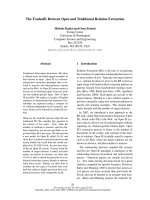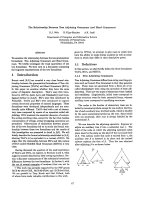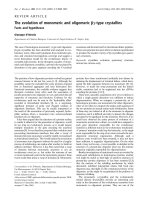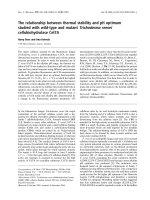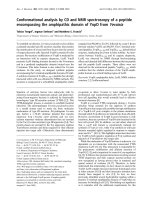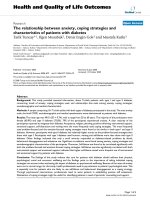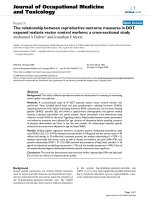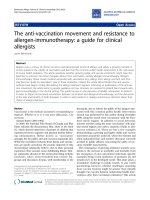Báo cáo y học: "The relationship between cancer and rheumatoid arthritis: still a large research agenda" ppsx
Bạn đang xem bản rút gọn của tài liệu. Xem và tải ngay bản đầy đủ của tài liệu tại đây (36.66 KB, 2 trang )
Page 1 of 2
(page number not for citation purposes)
Available online />Abstract
The association between rheumatoid arthritis (RA) and malignan-
cies has received increased attention in recent years. Reports
suggesting that tumor necrosis factor blockers might elevate the
risk of malignancy in RA patients have prompted researchers to
look at the incidence of malignancies in all RA patients. In a recent
issue of Arthritis Research & Therapy, Smitten and colleagues
suggest that previous reports of a standardized incidence ratio
close to one for malignancies in RA may reflect an increased risk
for some site-specific malignancies and a reduced risk for others.
Here we discuss these findings and suggest what issues could be
addressed in future studies.
In a recent issue of Arthritis Research & Therapy, Smitten
and colleagues [1] reported the results of a meta-analysis of
studies looking at the relative risk of malignancies in rheuma-
toid arthritis (RA) patients compared to the general popula-
tion, as expressed by a standardized incidence ratio (SIR).
While their finding of a SIR of 1.05 for all malignancies in this
group supports previous studies, they report SIRs for lymphoma
of 2.08 and lung cancer of 1.63, and decreased relative risks
for colorectal cancer of 0.77 and breast cancer of 0.84.
These results suggest that the previously reported SIR close
to 1 for all malignancies in RA patients [2] may be explained
in part by an increased relative risk for some site-specific
malignancies and a reduction in the relative risk for others.
When attempting to separate the reported association
between malignancy and RA, the subject of the review by
Smitten and colleagues, from the association reported for
tumor necrosis factor (TNF) blockers [3], it is important to
avoid bias introduced by different patterns of drug use.
Smitten and colleagues did not separately analyze TNF
blocker treated patients, with 4,917 RA patients from studies
on TNF blockers included with other studies for the main
analysis. However, given that these two groups of patients on
TNF blockers represent only 2.2% of the overall cancer group
and 2.9% of the lymphoma group, it seems reasonable to
conclude that these patients did not have a large effect on
the overall relative risks.
A study by Baecklund and colleagues [4] suggested that
there is a relationship between the level of inflammation in RA
patients and their risk of developing lymphoma. This
strengthens the hypothesis that the association observed
between TNF blockers and lymphomas is a consequence of
severe RA patients being more likely to receive such drugs. It
is also possible that TNF blockers may abolish a TNF-driven
mechanism that keeps an indolent lymphoma in check.
Should such a mechanism exist, one would expect a spike of
lymphomas in the early period of drug use, with an incidence
trending down and settling at a rate higher than the baseline
seen in RA patients but below the initial spike. Long-term
studies of lymphoma incidence in patients treated with TNF
blockers are needed to determine if such a pattern will
emerge over time. Another possibility is that prolonged TNF
blockade will result in a decrease in chronic inflammation,
thereby lowering the risk of lymphoma in RA patients in the
long-term. Both of these models may turn out to be true, as
they are not mutually exclusive.
The discussion by Smitten and colleagues provides an
excellent summary of potential explanations for the variable
risk across different site-specific malignancies in RA patients.
As Baecklund and colleagues’ work suggests, ongoing
inflammation may, over time, increase the risk of malignant
transformation in cells of the immune system, thereby
increasing the rates of lymphomas [4]. Similarly, the
increased risk for lung cancer may be explained by chronic
lung inflammation in RA, but the fact that smoking is a risk
factor for both RA and lung cancer may also contribute to the
Editorial
The relationship between cancer and rheumatoid arthritis:
still a large research agenda
Thorvardur Love and Daniel H Solomon
Division of Rheumatology, Immunology, and Allergy, Brigham and Women’s Hospital, Harvard Medical School, Francis Street, Boston, MA 02115, USA
Corresponding author: Daniel H Solomon,
Published: 14 May 2008 Arthritis Research & Therapy 2008, 10:109 (doi:10.1186/ar2417)
This article is online at />© 2008 BioMed Central Ltd
See related research by Smitten et al., />RA = rheumatoid arthritis; SIR = standardized incidence ratio; TNF = tumor necrosis factor.
Page 2 of 2
(page number not for citation purposes)
Arthritis Research & Therapy Vol 10 No 3 Love and Solomon
observed elevated risk. Increased NSAID (non-steroidal anti-
inflammatory drug) use may be a factor in protecting RA
patients from colon cancer. This possibility is suggested by
results of the APPROVE trial, which showed rofecoxib
reduces the recurrence of adenomatous polyps as well as the
risk of advanced adenomas at one and three years after
randomization [5]. Use of immune modulating therapies in RA
may also underlie the observed reduction in breast cancer
incidence, but the mechanism is not clear.
The important meta-analysis presented by Smitten and
colleagues pushes our understanding of malignancy in RA
forward but raises many important questions for future
research. First, as much of the literature they cite (and most of
the patients included in the meta-analysis) is from Sweden, one
might ask whether similar patterns of risk would be observed in
patients from other ethnic backgrounds. Comparing the
Swedish results with those of other studies might give an
insight into whether different ethnic backgrounds influence the
risk for malignancies in RA patients, thereby suggesting a
genetic link between these diseases. Second, in the case of
lung cancer it would be very useful to improve the control for
potential confounding introduced by tobacco use. This might
be achieved with better long-term tobacco histories. Third, as
we learn to subtype RA, it would be important to look at the
relationship between anti-cyclic citrullinated peptide antibody
status and malignancy. Is the risk of lymphoma primarily seen in
certain subgroups? This risk might be magnified by specific
genetic risk alleles (for example, shared epitope, PTPN22,
STAT4). Finally, the clinical relevance of these data regarding
RA and malignancy is unclear. Should clinicians screen RA
patients differently than typical patients?
Competing interests
The authors declare that they have no competing interests.
Acknowledgements
DHS receives salary support from the NIH (AR 047782 and
AR055989).
References
1. Smitten AL, Simon TA, Hochberg MC, Suissa S: A meta-analysis
of the incidence of malignancy in adult patients with rheuma-
toid arthritis. Arthritis Res Ther 2008, 10:R45.
2. Chakravarty EF, Genovese MC: Associations between rheuma-
toid arthritis and malignancy. Rheum Dis Clin North Am 2004,
30:271-284, vi.
3. Bongartz T, Sutton AJ, Sweeting MJ, Buchan I, Matteson EL,
Montori V: Anti-TNF antibody therapy in rheumatoid arthritis
and the risk of serious infections and malignancies: system-
atic review and meta-analysis of rare harmful effects in ran-
domized controlled trials. JAMA 2006, 295:2275-2285.
4. Baecklund E, Iliadou A, Askling J, Ekbom A, Backlin C, Granath F,
Catrina AI, Rosenquist R, Feltelius N, Sundstrom C, Klareskog L:
Association of chronic inflammation, not its treatment, with
increased lymphoma risk in rheumatoid arthritis. Arthritis
Rheum 2006, 54:692-701.
5. Baron JA, Sandler RS, Bresalier RS, Quan H, Riddell R, Lanas A,
Bolognese JA, Oxenius B, Horgan K, Loftus S, Morton DG;
APPROVe Trial Investigators: A randomized trial of rofecoxib
for the chemoprevention of colorectal adenomas. Gastroen-
terology 2006, 131:1674-1682.
